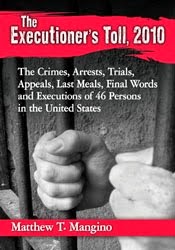In 2009, Alex Blueford sat before an Arkansas jury and listened as the jury foreperson told the judge that she and her fellow jurors were unanimous in finding that Blueford was not guilty of capital murder or first-degree murder. Yet, less than an hour later, a mistrial was declared and Blueford would once again face a jury on both charges.
The Pennsylvania Law Weekly
June 5, 2012
In 2009, Alex Blueford sat before an Arkansas jury and listened as the jury foreperson told the judge that she and her fellow jurors were unanimous in finding that Blueford was not guilty of capital murder or first-degree murder. Yet, less than an hour later, a mistrial was declared and Blueford would once again face a jury on both charges.
On Nov. 28, 2007, Blueford was babysitting his girlfriend's 20-month-old son while she took a relative to an appointment. Shortly after leaving, the toddler stopped breathing. Another adult in the home called for help. The child later died in the hospital. The cause of death — a traumatic closed head injury.
According to court documents, Blueford was charged with murder. The prosecutors pursuing Blueford called a pediatrician and the state medical examiner. Both compared the child's injuries to those from a serious car accident. Prosecutors contended the injuries were intentional.
At trial, Blueford took responsibility for the child's injuries, but suggested the injury was the result of a tragic accident. Blueford said he was startled when the toddler waved a lit cigarette near his face, causing him to accidentally hit him in the head and knock him to the floor.
The court's instructions to the jury required the panel to consider the offenses of capital murder, first-degree murder, manslaughter and negligent homicide. The state of Arkansas' jury instructions specifically direct jurors not to consider the lesser charges until they make a unanimous decision on the more serious charge.
There are two basic approaches to jury deliberations regarding lesser offenses. A majority of jurisdictions use an "acquittal-first" instruction, requiring juries to unanimously convict or acquit the defendant of an offense before considering less serious charges.
Twenty-three other jurisdictions, including Pennsylvania, allow courts to give an "unable to agree" instruction. In these jurisdictions, the jury will consider a less serious charge after making reasonable efforts to reach a verdict on a more serious charge and finding itself unable to agree (Daniels v. Washington, 130 S.Ct. 85, 2009, Petition for Writ of Certiorari).
After deliberating for several hours, the Blueford jurors notified the court that they were hopelessly deadlocked. In explaining the deadlock to the judge, the foreperson stated that the jury was unanimously against charges of capital murder and first-degree murder, and nine of the 12 jurors were in favor of manslaughter. The following colloquy was entered on the record in open court:
The court: "All right. If you have your numbers together, and I don't want names, but if you have your numbers I would like to know what your count was on capital murder."
Juror Number One: "That was unanimous against that. No."
The court: "Okay, on murder in the first degree?"
Juror Number One: "That was unanimous against that."
Blueford asked for a partial verdict on the two most serious charges. The judge declined and instructed the jurors to continue deliberations. After the jury again reported a deadlock, the judge declared a mistrial.
The prosecution indicated the state's intention to retry Blueford. He moved to dismiss the capital and first-degree murder charges, citing the double jeopardy clause embodied in the Fifth Amendment to the U.S. Constitution. The trial court denied the motion, and the Supreme Court of Arkansas affirmed.
Blueford's case ultimately made its way to the U.S. Supreme Court. During oral argument in Blueford v. Arkansas, No. 10-1320, the petitioner's counsel zeroed in on the jury foreperson's statement that the jury had unanimously voted not guilty on the two most serious offenses. In responding to a question by Justice Stephen Breyer, Clifford M. Sloan, Blueford's attorney, said, "With respect, your honor, I disagree that it's a minor matter when a foreperson stands up, with the jury present, and says we have voted not guilty."
However, Justice Samuel Alito provided some insight into where the court was heading. Alito told Sloan, "The one characteristic of a verdict that seems perfectly clear to me is that it is final."
The double jeopardy clause provides that no person shall "be subject for the same offence to be twice put in jeopardy of life or limb." The Fifth Amendment provides that the state should not be allowed to use its power and resources to repeatedly attempt to convict a defendant and thereby subject him to embarrassment, expense and anxiety and increasing the possibility that he be found guilty despite his innocence (Green v. United States, 355 U.S. 184 (1957)).
The Supreme Court found that the jury foreperson's statement of the jury's position was not final. The double jeopardy clause does not prevent the reprosecution of a greater offense if a jury deadlocks on a lesser offense.
"The jury in this case did not convict Blueford of any offense, but it did not acquit him of any either," Chief Justice John G. Roberts Jr. wrote on behalf of the majority.
The court provided a hypothetical to bolster its position. The court theorized this: A jury begins its deliberations with a vote on first-degree murder. Everyone votes not guilty. The foreperson calls for a vote on manslaughter and the vote is split. The jurors then begin to discuss the case. At that point one of the jurors begins to rethink his vote on first-degree murder and changes to guilty.
Roberts concluded, "It was therefore possible for Blueford's jury to revisit the offenses of capital and first-degree murder, notwithstanding its earlier votes." He added, "And because of that possibility, the foreperson's report prior to the end of deliberations lacked the finality necessary to amount to an acquittal on those offenses."
Although plausible, Roberts' hypothetical did not reconcile with the facts in Blueford. Nor did the hypothetical resonate with all members of the court.
Justice Sonia Sotomayor dissented, joined by Justices Ruth Bader Ginsburg and Elena Kagan. She wrote, "Blueford's jury had the option to convict him of capital and first-degree murder, but expressly declined to do so."
The theory behind the "acquittal-first" jury instruction was to avoid double jeopardy problems by requiring the jury to render a verdict on the most serious charge or to hang without reaching any other charges, thereby allowing a new trial on all charges.
Blueford provided a different scenario — unanimity on the most serious charges and deadlock on the less serious charges. Sotomayor pointed to such a scenario when she wrote, "It would be anomalous if the double jeopardy clause offered less protection to a defendant whose jury has dead locked on the lesser and thus convicted of nothing at all."
The trial judge in Blueford should have honored Blueford's request for a partial verdict before declaring a mistrial on the deadlocked manslaughter offense — double jeopardy would have attached and justice would have been served. In light of Blueford, trial courts would do well to consider partial verdicts under similar circumstances.







